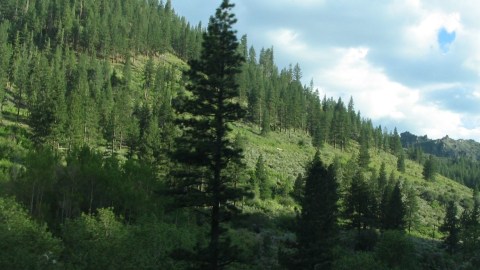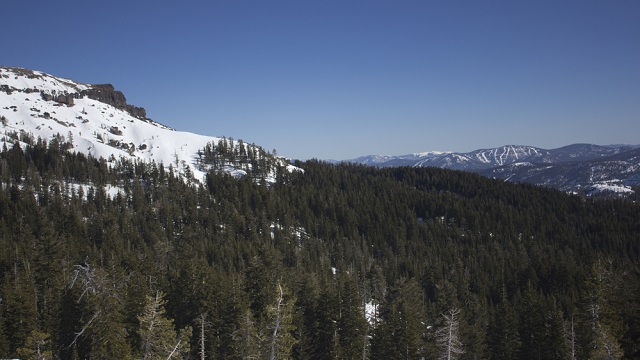Is it possible to have too many trees?

- Recent research indicates that dense forests in the Sierra Nevada drain billions of gallons of water from the watershed each year.
- Unusually dense tree stands degrade the vitality of the land, plants, animals, and even the trees.
- Experts recommend managing forest restoration through controlled fires and the thinning of small, fire-prone trees.
Many people view trees as an unassailable good. We learned about their ecological importance every Earth Day. In-between after-school cartoons, public service announcements told us trees were our friends. Celebrities like John Denver sang that trees weren’t just essential for our future but America’s, too.
The assumption was as clear as it was unspoken: If one tree is good, two trees are better, and 20 trees better still. But that’s not proving the case in California’s Sierra Nevada forests, where too many trees may threaten the state’s ecological stability.

Restored Sierra Nevada forest stands in the foreground with unthinned forest in the background.
Photo credit: Eric Knapp/United States Forest Service via National Science Foundation)United States Forest Service via National Science Foundation
Too many trees, too little water
Roughly 60 percent of California’s consumable water comes from the Sierra Nevada watersheds, which is why the mountains are nicknamed California’s water towers. This mountain range collects snowpack at its higher elevations during the cold winter. Come spring and summer, this snowpack melts and travels into streams, rivers, and underground springs before flowing into the valleys below.
But according to the National Science Foundation (NSF), forested areas in the Sierra Nevada with a surfeit of trees are draining the state’s water at an untenable rate.
Trees consume a lot of water to survive. To slake their biological thirst, some species, such as conifers, can extend their roots as far down as 15 meters to access deep-soil water. Once consumed, the water moves up their trunks and into the leaves where it escapes into the atmosphere through tiny pores. This process, called evapotranspiration, removes water from the watershed and renders it inaccessible until it returns as rainfall.
It’s inherently a natural process; however, excessive evapotranspiration can stress an area’s vital water resources, especially during prolonged droughts.
Researchers at the NSF’s South Sierra Critical Zone Observatory looked at water loss from evapotranspiration using data from measurement towers and satellites. They found that forests naturally thinned by wildfires saved billions of gallons of water. From 1990 to 2008, California’s Kings River Basin saved 3.7 billion gallons of water annually thanks to its fire-thinned forests. The American River Basin saved 17 billion gallons per year during the same period. Their research was published in Ecohydrology last year.
“Forest wildfires are often considered disasters,” Richard Yuretich, director of the NSF’s South Sierra Critical Zone Observatory, which funded the research, said in a release. “But fire is part of healthy forest ecosystems. By thinning out trees, fires can reduce water stress in forests and ease water shortages during droughts. And by reducing the water used by plants, more rainfall flows into rivers and accumulates in groundwater.”
According to the researchers, “the total effect of wildfires over a 20-year period suggests that forest thinning could increase water flow from Sierra Nevada watersheds by as much as 10 percent.”
Through effective forest husbandry, water gains could potentially extend nationwide, but the task is immense. Citing U.S. Forest Service data, the researchers note that 58 million acres of forest require restoration nationally. The costs? An estimated $5 to $10 billion for California alone.

The Rim Fire of the Stanislaus National Forest, Sierra Nevada, Cali. Suppression efforts cost more than $127 million.
The costs of being (too) green
A recent study published in Nature Geoscience suggests people won’t be the only benefactors of thinner Sierra Nevada forests. The tress will profit, too.
Researchers from the University of California, Irvine, and UC Merced used field and remote sensing observations to examine tree communities in the mountain range. Focusing on the disastrous 2012–15 dry-spell, they attempted to suss out the causes of the area’s widespread tree death. In addition to the below-average rainfall and above-average temperatures, the researchers also noted the “unusually dense vegetation.”
Because of the heat-density combination, trees accelerated evapotranspiration and drew more water from the ground than was replenished, resulting in the die-off. Trees at lower elevations were hit the hardest.
“We expect climate change to further amplify evapotranspiration and ground moisture overdraft during drought,” Michael Goulden, UCI professor of Earth system science and the study’s co-author, said in a release. “This effect could result in a 15 to 20 percent increase in tree death during drought for each additional degree of warming.”
As one expects, an unhealthy community of trees ripples out to create an unhealthy environment for all. As Jamie Workman, writer for the Environmental Defense Fund, points out in an op-ed:
“Metastasizing native tree growth also physically alters the temperature, chemistry and biology of the landscape. It crowds out indigenous plant and animal species. Shade tolerant species take over. Deprived of low-intensity, naturally occurring fires, aspen, lupine, sequoia and fireweed can’t reproduce. Deer lose edge habitat. Threatened owls and raptors can’t navigate through increasingly dense thickets.”
When the inevitable forest fire does occur, Workman adds, it burns hotter, longer and faster. These conflagrations cost more, either as dollars spent to suppress them or lost land, property, and life (sometimes all of the above). According to the U.S. Forest Service, the average cost of fire operations in recent years has been approximately $2 billion annually.
Workman’s recommendation is to open Western forests to careful, deliberate thinning. He argues that local private and public entities could manage the forest by removing fire-prone trees and debris, either through logging or controlled fires. Not only would this increase the health of Western forests, it would protect water supplies worth well more than the costs of investment.
“We’ve known for some time that managed forest fires are the only way to restore the majority of overstocked western forests and reduce the risk of catastrophic fires,” James Roche, a National Park Service hydrologist and lead author of the Ecohydrology study, said in the same release. “We can now add the potential benefit of increased water yield from these watersheds.”
Acts of ecological juggling
For those of us raised on John Denver and Smokey the Bear, the idea of logging or letting forests burn runs counter-intuitive toward the belief that abundant green equals a healthy ecosystem. It brings to mind worries that big companies may clear cut national forests — placed in public trust for future generations — and that the emissions will exacerbate our already fraught battle with climate change.
These are legitimate concerns.
The U.S. Congress, particularly its Republican representatives, has a history of using devastating wildfires to gin up support for legislation that would limit oversight of the logging industry, open federal lands to private companies, and curb environmental reviews of certain practices, including clear-cutting.
It’s been shown that traditional logging practices increase an area’s burn capacity. The large trees targeted by loggers are mature and thick-barked, which are more resistant to fire. Meanwhile, the small trees and debris left behind are easily combustible.
However, when performed in good faith and with oversight, targeted clearing efforts can be part of healthy forest management. Controlled fires can sterilize old forests from native fungi that can breed insatiably on old rot. They give new life to tree species such as the Douglas-fir, an evergreen conifer that regenerates following a fire but not well in the shade of an established canopy. And the emissions from controlled, centralized thinning have been overrated in the cultural imagination.
Nor should we confuse the type of burning prescribed by these experts with the inferno-fueled deforestation currently occurring in the Amazon rainforest. The number of active fires in the Amazon is above the historic average with deforestation more than double last year. These burns are not inspired by conservation but industrialization and weakened environmental protections.
We must accept that healthy forest management is a juggling act that requires us to consider, calculate, and react to many different facets. These include reforestation, species selection, fertilization practices, irrigation and drainage practices, and many others. Additionally, forest management is not uniform. Practices that groom a healthy temperate forest, like those found in the Sierra Nevada, don’t translate to tropical forests.
But if the question is, is it possible to have too many trees? The answer yes, sometimes, in some places.





